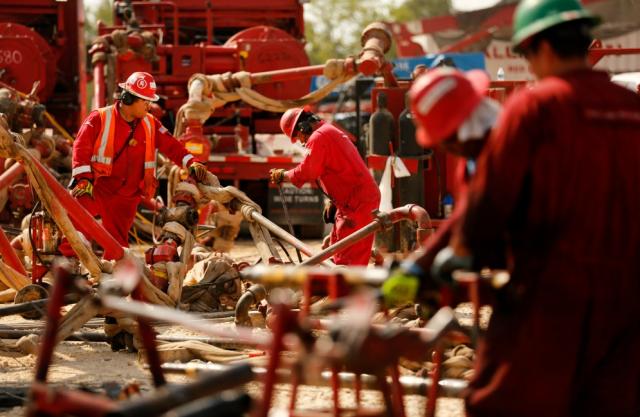
Fracking crew making adjustments between fracs in the upper Eagle Ford Shale. (Source: Tom Fox/Hart Energy)
HOUSTON—A second wave of production growth from U.S. shale may be forecasted by the International Energy Agency (IEA), but OPEC Secretary-General Mohammad Barkindo is not fazed.
Instead, Barkindo told attendees of CERAWeek by IHS Markit on March 11 he not only welcomes the revival of the U.S. oil and gas industry but attributes its strong rebound partly to the cooperation between OPEC and non-OPEC producers led by Russia over the past couple of years.
Despite restored confidence in the U.S., Barkindo issued a warning for the need of additional oil supply growth, not only from the U.S. but other regions as well, in order to meet global oil demand, which he said will remain strong.
“What we need to focus on now is that this rebound, as the result of the short-cycle investment that pumped into the shale basins, should also now be reflected in the long-cycle projects around the world. … The shrinkage in investment in the last couple of years is still a huge challenge because this rebound is only in the U.S. Outside the U.S. we've seen just a trickling of investment capital coming back into the industry,” he said.
Barkindo also said the rebalancing of oil markets is a “work in progress.”
OPEC and its allies began new production cuts earlier this year, agreeing to reduce supply by 1.2 million barrels per day (MMbbl/d) for six months.
Barkindo indicated that OPEC and allies will continue supply adjustments through 2019. The producers will meet in Vienna in April with another gathering scheduled for late June.
Earlier in the day, the IEA released a report projecting the U.S. as leading future global oil supply growth, adding another 4 MMbbl/d of oil production over the next five years.
RELATED: IEA Projects US Leading Global Oil Supply Growth
The U.S. is currently the world’s largest producer of crude, thanks to a boom driven by shale production, with record output of more than 12 MMbbl/d, according to data from the U.S. government. Production in the U.S. has risen by about 2 MMbbl/d in the last year alone.
The major finding from the IEA repot, according to Fatih Birol, IEA’s executive director who spoke alongside Barkindo on the panel during CERAWeek, was that the U.S. is entering into a second phase of the shale revolution.
The first phase was mainly the production of shale oil and gas for domestic purposes. “But now,” he said, “the second phase is starting namely making the U.S. a major energy exporter changing the direction of the trade flows in oil and gas.”
Birol sees the U.S. overtaking Russia in the next three years and Saudi Arabia in the next five years in terms of oil exports. Also, in terms of natural gas, he said 75% of LNG exports will come from the U.S.
Global oil demand growth is set to ease as China slows, but will still rise by an annual average of 1.2 MMbbl/d to 2024 when it will reach 106.4 MMbbl/d.
Still, the IEA does not see a peak in global demand with Birol noting that moves such as greater adoption of electric cars will not put a cap on demand growth just yet.
Despite the record number of electric cars sold last year, oil demand continued to increase. Birol said this was because cars only make up 19% of global oil consumption.
“When we look at the dynamics of the oil demand growth, cars are not the major drivers,” he said. “Drivers are trucks, petchem, aviation and shipping—these are the main drivers.”
Emily Patsy can be reached at epatsy@hartenergy.com. Reuters contributed to this article.
Recommended Reading
Well Logging Could Get a Makeover
2024-02-27 - Aramco’s KASHF robot, expected to deploy in 2025, will be able to operate in both vertical and horizontal segments of wellbores.
The Need for Speed in Oil, Gas Operations
2024-03-22 - NobleAI uses “science-based AI” to improve operator decision making and speed up oil and gas developments.
E&P Highlights: March 4, 2024
2024-03-04 - Here’s a roundup of the latest E&P headlines, including a reserves update and new contract awards.
Tech Trends: Halliburton’s Carbon Capturing Cement Solution
2024-02-20 - Halliburton’s new CorrosaLock cement solution provides chemical resistance to CO2 and minimizes the impact of cyclic loading on the cement barrier.
E&P Highlights: March 15, 2024
2024-03-15 - Here’s a roundup of the latest E&P headlines, including a new discovery and offshore contract awards.





